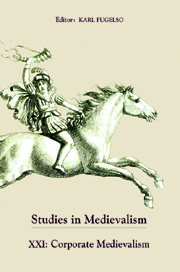Book contents
- Frontmatter
- Acknowledgments
- Contents
- Title in the Series
- Editorial Note
- I Corporate Medievalism: Some Perspective(s)
- Lives of Total Dedication? Medieval and Modern Corporate Identity
- Reincorporating the Medieval: Morality, Chivalry, and Honor in Post-Financial-Meltdown Corporate Revisionism
- Medievalism and Representations of Corporate Identity
- Knights of the Ownership Society: Economic Inequality and Medievalist Film
- A Corporate Neo-Beowulf: Ready or Not, Here We Come
- Unsettled Accounts: Corporate Culture and George R. R. Martin's Fetish Medievalism
- II Interpretations
- III Response
- Notes on Contributors
- Title in the Series
Medievalism and Representations of Corporate Identity
from I - Corporate Medievalism: Some Perspective(s)
Published online by Cambridge University Press: 05 February 2013
- Frontmatter
- Acknowledgments
- Contents
- Title in the Series
- Editorial Note
- I Corporate Medievalism: Some Perspective(s)
- Lives of Total Dedication? Medieval and Modern Corporate Identity
- Reincorporating the Medieval: Morality, Chivalry, and Honor in Post-Financial-Meltdown Corporate Revisionism
- Medievalism and Representations of Corporate Identity
- Knights of the Ownership Society: Economic Inequality and Medievalist Film
- A Corporate Neo-Beowulf: Ready or Not, Here We Come
- Unsettled Accounts: Corporate Culture and George R. R. Martin's Fetish Medievalism
- II Interpretations
- III Response
- Notes on Contributors
- Title in the Series
Summary
Anyone who has popped a quarter into the arcade version of Gauntlet from the early 1980s, brought home a console game such as those of Nintendo's Zelda series, or renewed a subscription to the currently popular World of Warcraft has not only exchanged money for the privilege of playing a game, but has also purchased a commodified representation of the Middle Ages. Many of these games borrow design elements from common understandings of the European Middle Ages, including settings, narratives, clothing, professions, and architecture. These borrowings, however, often make no claims to historical accuracy or realism, and their situation within the processes of the games themselves quite easily characterizes them as instances of neomedievalism as defined by Robinson and Clements. Most of these games have a particular objective – such as fulfilling a quest – and position the player as an adventurer or hero who must use a combination of fighting abilities and magic to kill enemies. Such accomplishments lead to more advanced skills and an increased ability to defeat more powerful enemies, as well as the acquisition of gold – or whatever currency functions within the game – and other useful items such as food, armor, and weapons. In some games, a player can even hone “professional” skills that allow her to develop the ability to craft and sell advanced armor and weapons.
What interests us here are the processes by which players in neomedieval digital games interact with other entities and groups in order to fulfill these game objectives. In addition to the visual tropes listed above, neomedieval digital games also implement social hierarchies and economic arrangements inspired by lexical re-positionings of medievalesque tropes such as guilds, questing groups, and various other incorporated entities.
- Type
- Chapter
- Information
- Studies in Medievalism XXICorporate Medievalism, pp. 27 - 36Publisher: Boydell & BrewerPrint publication year: 2012



